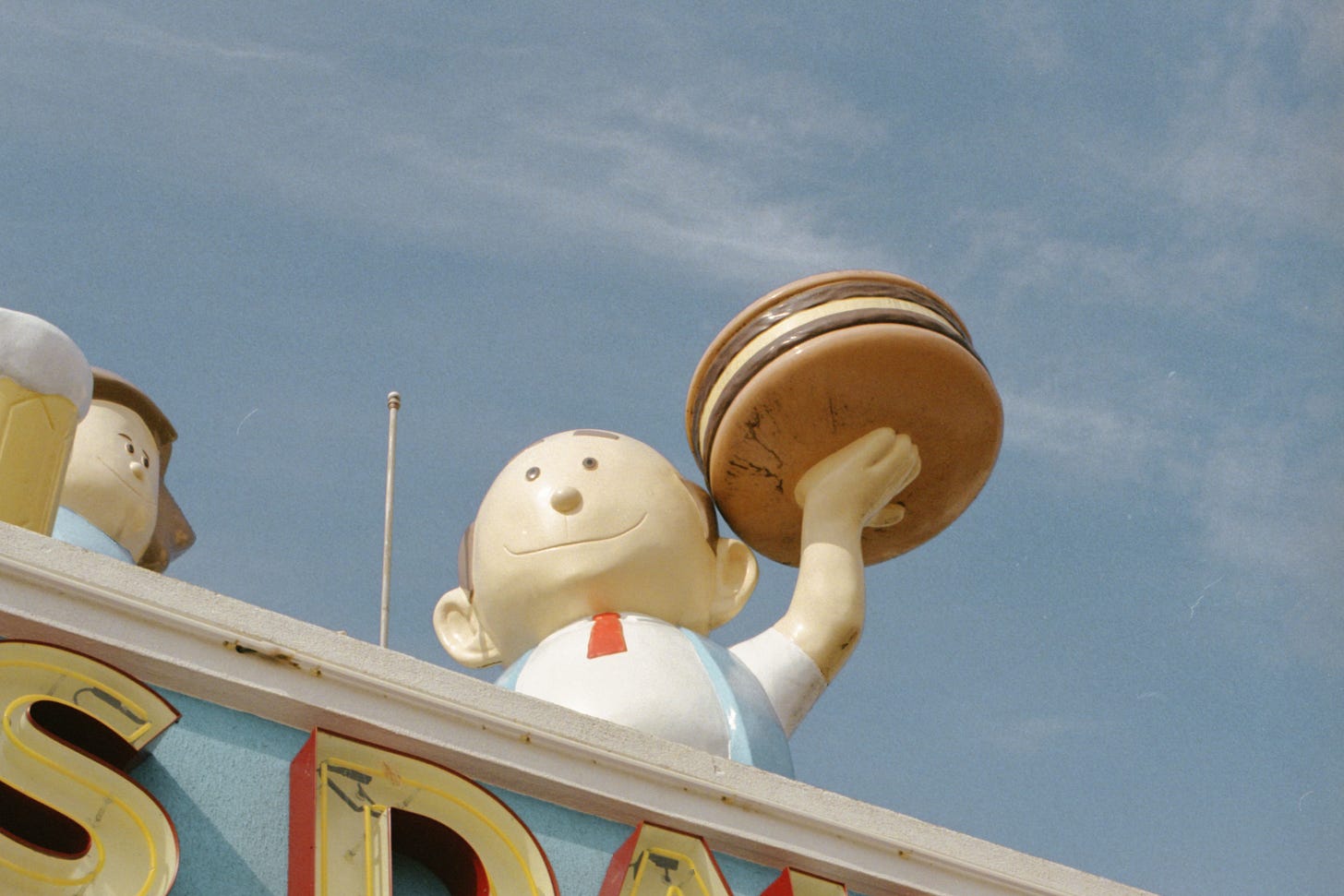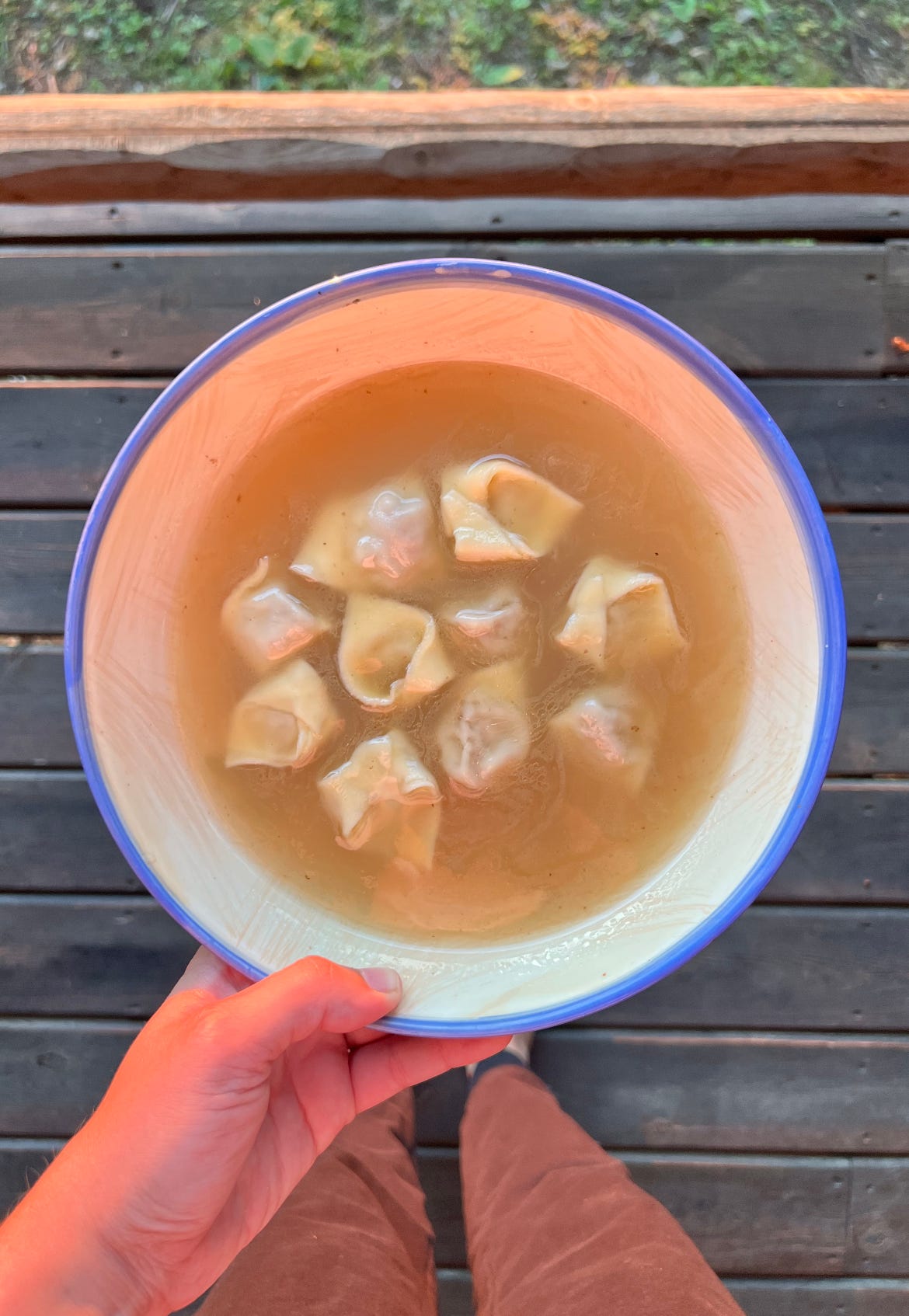"Everything on the menu is good!"
How to pick a bottle of wine or a bag of coffee—and an update.
Before we begin, a quick (and timely) announcement: My colleague Jason Wilson, who writes a newsletter called Everyday Drinking, and who was part of my Substack Food Writers Intensive group, recently republished a story I wrote about how orange wine is a bad tasting note. Give it a read, and subscribe to his excellent newsletter while you’re at it!
Recently, I went to my friend’s cafe for coffee. They serve two types of espresso: a house blend and a rotating single-origin coffee. I ordered an espresso, and the person at the register (who I know, and who is lovely and charming) asked me which one I’d like. The exchange went as follows (only slightly exaggerated for comedic effect):
Barista: “Do you know which espresso you’d like?”
Ashley: “Whichever one tastes the best.”
Barista: “How dare you, they’re both delicious.”
Again, the barista and I are friends, so this was a funny moment—but it did get me thinking about how we seek out the things we like. When I worked behind the bar, customers would always ask me: “What’s good here?” I don’t think I ever came up with a solid answer, other than sheepishly replying: “I think everything is good?” This became my default response after making multiple attempts to guess what someone might like—and getting it woefully wrong every time.
How dare you keep reading and not be a paid subscriber?! I’m just kidding, but please consider supporting my work financially if you can:
But as hard as it can be to answer a question like “What’s good here?”, I can still sympathize with the customers asking it. I don’t think, within the realm of food and drink, we’ve worked out a robust or reliable way to connect people with the products they like. I know that because I’m also on the other end of the equation: I almost always choose things on a menu based on recommendations from the server, bartender, or barista. Looking at most menus, I just can’t predict what will make me dance with joy versus leave me wanting more, and it’s comforting to get a second opinion.
These ideas featured significantly in the latest episode of the podcast, a conversation with Marie Cheslik of Slik Wines. Marie is a wine professional, and she makes educational videos that she shares on various social platforms. We talked at length about how we make decisions when picking out a bottle of wine:
Marie: I think about situations that I always thought about when I was first learning and I try not to lose that perspective—things that I think to my colleagues seem really basic and really 101 are the things that people need to hear and need to hear over and over again. It’s worth saying more than once.
Ashley: What do you think some of those things are?
Marie: Just even how to pick a bottle of wine off the shelf.
I really like to push labels for people because its usually the first thing people see and usually what people make their buying decisions off of, right? Whether it’s a cute label or it gives you information—and of course, a cute label is cute, but doesn’t really tell you anything about the wine, unless when you look on the back label and you see the importer and you go, “Okay.” But you have to know what an importer is…
Marie and I spoke about how reverting back to the basics, and keeping things simple, is a key educational approach in esoteric fields like coffee and wine. Yet for those who are already enmeshed in those industries, it can be challenging to get back to that beginner’s mindset.
And so, a task: Pull out a bag of coffee, either the next time you’re at the grocery store or in your home. Try to pick the “fanciest” one. Now, look at the information given to you on the bag and ask, “Do I actually know what any of this means?” If you’re a coffee pro, try this exercise with a bottle of wine or a can of beer instead. What does the information on the bottle actually tell you?
One of the reasons Marie brought up looking for the importer on the label is because I told her that’s how I pick wine, which isn’t too far removed from letting the chef/bartender/barista pick for me. This method only really works for me because of three factors: One, I’m not picky; two, I have no food allergies; and three, I’ve worked in service, so I generally understand the lingo behind the bar and I feel calibrated to other service professionals. But I represent a small minority of consumers—and even with that industry experience, I’m still trying to work out how to better convey concepts like taste and quality to others.
Tasting notes are often our primary tool when describing both coffee and wine—one that seems more accessible than sharing information about appellations or fermentation styles—but they’re far from a perfect metric. You can hear me complain about tasting notes here, or revisit my piece about why orange wine is a bad tasting note for more.
In contrast, I think folks like Marie are helping people make informed decisions, or are at least giving them a little more insight into what might make a wine likable or not. I don’t think I’ve ever cracked this code with coffee, but I do find myself reaching beyond tasting notes to describe the qualitative experience of different coffees as “everyone will like this” or “goes well with milk” or “something really special and fun.”
Interestingly, Marie noted that occasion-based recommendations can create moments of relatability: Many of the questions she’s asked fall along the lines of, “What should I get to impress my boss?” or “What would be good for the holidays?”
Those are situations and desires that are more communicable—the feeling of wanting to pick something outstanding yet affordable when we aim to impress, something easy and crowd-pleasing when we’re with family. It can be difficult for a barista or a bartender or wine shop assistant to ascertain a customer’s preferences, and equally confusing for customers to know if what their service professionals are recommending will meet their expectations. Perhaps asking questions about when and how something will be enjoyed is a more direct approach.
Within a coffee context—if you find yourself asking the barista for recommendations, but not necessarily knowing the difference between a coffee with notes of “citrus and spice” and one that’s “floral and sweet”—you can ask questions like:
Is this an everyday coffee?
Do you think a wide variety of people might like it?
I want to bring something special for X occasion—what would stand out?
There’s no one answer to any of these queries, but each provides the necessary context for a barista to make recommendations instead of guessing what you might like (especially because, like I’ve said in coffee shops past, “Everything is good here!”). The first question tells me you’re looking for something reliable, priced for regular purchase, and available year-round. The second tells me you need something that can withstand milk and sugar and can be brewed a number of ways. The third tells me that you’re ready for something with a story—something you can share with friends that can mark a memorable moment or fuel conversation.
If you’re curious and keen to learn, I’ll leave you with Marie’s final piece of advice when picking out a bottle of wine:
When you are out buying a bottle of wine, I would say the most important thing would be buying from small wineries, buying from people who don’t make a ton of wine, spending a little bit more on a bottle of wine—probably much like coffee—really goes a long way.
Cover photo by Annie Spratt on Unsplash
Update City:
I recently took a month away from the newsletter, during which I contemplated shutting down Boss Barista entirely. The work I do here is so important to me, but in the spirit of transparency, I’ve been feeling uncomfortably aware of how public, and how exposed, it can make my life feel. This is a new feeling for me (I’m generally an over-sharer), and I think I’ve been holding in pain and self-doubt about the validity of my own feelings, which has left me feeling trapped. I’m still working through this, but I think I’m making progress. Sharing this with you is part of an exercise to accept and normalize these feelings.
In the last few months, I’ve published a fair amount of work, including a set of interviews with Taste Cooking, a few how-tos with Serious Eats, and some cleaning articles with very catchy titles for The Kitchn. This is the first time in my life I’ve felt like a food writer, though I’ve also been struggling with feeling worried or embarrassed to share any of this work.
With all that said, I wanted to share a request, and an update: If you’ve left me a comment, if you’ve reached out to me, if you need me to respond to something, please remind me again. I’ve let a lot of things fall to the wayside simply because I couldn’t bear to face them. I am also establishing one rule to this newsletter: If I believe you are arguing or commenting on my work in bad faith, I will not engage. That decision is mine to make, and I will not accept challenges to that.
I’d also love to know what’s on your mind. I got some great feedback about last week’s quiet-quitting story (a lot of people sent me emails, which I LOVED—please do more of that!), and I was touched by how many people have responded to some of the other posts I’ve shared (namely, all the pasta I made). Would you want to hear about more of these adventures? Is cooking/life stuff interesting to you folks? Let me know!
Lastly, are there any topics you’d be interested in me covering here? Tell me about it in the comments below!
Thanks for being here with me, and I love having you here. Here’s more pasta—this is tortellini stuffed with pork shoulder, mortadella, and prosciutto in brodo from Odette Williams’ book “Simple Pasta”:






Let’s chat about dry/wet washed, mild-dark and it’s process
Ty. Great stuff